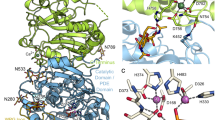Abstract
3′-Phosphoadenosine-5′-phosphosulfate (PAPS) is the obligate cosubstrate and source of the sulfonate group in the chemoenzymatic synthesis of heparin, a clinically used anticoagulant drug. Previously, we have developed a method to synthesize PAPS with Escherichia coli crude extracts, which include three overexpressed enzymes and a fourth unidentified protein. The unknown protein degrades adenosine diphosphate (ADP), the by-product of PAPS synthesis reaction. To further understand and control the process of in vitro enzymatic PAPS synthesis, we decide to identify the fourth protein and develop a defined method to synthesize PAPS using purified enzymes. Here, we show that the purified Nudix hydrolase NudJ degrades ADP at high efficiency and serves as the fourth enzyme in PAPS synthesis. Under the defined condition of PAPS synthesis, all of the 10-mM ADP is hydrolyzed to form adenosine monophosphate (AMP) in a 15-min reaction. ADP is a better substrate for NudJ than adenosine triphosphate (ATP). Most importantly, the purified NudJ does not cleave the product PAPS. The removal of ADP makes the PAPS peak more separable from other components in the chromatographic purification process. This developed enzymatic approach of PAPS production will contribute to the chemoenzymatic synthesis of heparin.






Similar content being viewed by others
References
Bhaskar U, Li G, Fu L, Onishi A, Suflita M, Dordick JS, Linhardt RJ (2015) Combinatorial one-pot chemoenzymatic synthesis of heparin. Carbohydr Polym 122:399–407
Bhatnagar SK, Bullions LC, Bessman MJ (1991) Characterization of the mutT nucleoside triphosphatase of Escherichia coli. J Biol Chem 266:9050–9054
Burkart MD, Izumi M, Chapman E, Lin CH, Wong CH (2000) Regeneration of PAPS for the enzymatic synthesis of sulfated oligosaccharides. J Org Chem 65:5565–5574
Burkart MD, Izumi M, Wong CH (1999) Enzymatic regeneration of 3′-phosphoadenosine-5′-phosphosulfate using aryl sulfotransferase for the preparative enzymatic synthesis of sulfated carbohydrates. Angew Chem Int Ed Engl 38:2747–2750
Burkart MD, Wong CH (1999) A continuous assay for the spectrophotometric analysis of sulfotransferases using aryl sulfotransferase IV. Anal Biochem 274:131–137
Chen J, Avci FY, Munoz EM, McDowell LM, Chen M, Pedersen LC, Zhang L, Linhardt RJ, Liu J (2005) Enzymatic redesigning of biologically active heparan sulfate. J Biol Chem 280:42817–42825
Cress BF, Linhardt RJ, Koffas MAG (2013) Draft genome sequence of Escherichia coli strain Nissle 1917 (serovar O6:K5:H1). Genome Announc 1
Gabelli SB, Bianchet MA, Bessman MJ, Amezel LM (2001) The structure of ADP-ribose pyrophosphatase reveals the structural basis for the versatility of the Nudix family. Nat Struct Biol 8:467–472
Hong M-K, Ribeiro AJM, Kim J-K, Ngo H-P-T, Kim J, Lee CH, Ahn Y-J, Fernandes PA, Li Q, Ramos MJ, Kang L-W (2014) Divalent metal ion-based catalytic mechanism of the Nudix hydrolase Orf153 (YmfB) from Escherichia coli. Acta Cryst D70:1297–1310
Hsieh P-H, Xu Y, Keire DA, Liu J (2014) Chemoenzymatic synthesis and structural characterization of 2-O-sulfated glucuronic acid-containing heparan sulfate hexasaccharides. Glycobiology 24:681–692
Just I, Wollenberg P, Moss J, Aktories K (1994) Cysteine-specific ADP-ribosylation of actin. Eur J Biochem 221:1047–1054
Lawhorn BG, Gerdes SY, Begley TP (2004) A genetic screen for the identification of thiamin metabolic genes. J Biol Chem 279:43555–43559
Legler PM, Massiah MA, Bessman MJ, Mildvan AS (2000) GDP-mannose mannosyl hydrolase catalyzes nucleophilic substitution at carbon, unlike all other Nudix hydrolases. Biochemistry (Mosc) 39:8603–8608
Liu R, Xu Y, Chen M, Weiwer M, Zhou X, Bridges AS, DeAngelis PL, Zhang Q, Linhardt RJ, Liu J (2010) Chemoenzymatic design of heparan sulfate oligosaccharides. J Biol Chem 285:34240–34249
McLennan AG (2006) The Nudix hydrolase superfamily. Cell Mol Life Sci 63:123–143
Mildvan AS, Xia Z, Azurmendi HF, Saraswat V, Legler PM, Massiah MA, Gabelli SB, Bianchet MA, Kang LW, Amzel LM (2005) Structures and mechanisms of Nudix hydrolases. Arch Biochem Biophys 433:129–143
O’Handley SF, Frick DN, Bullions LC, Mildvan AS, Bessman MJ (1996) Escherichia coli orf17 codes for a nucleoside triphosphate pyrophosphohydrolase member of the MutT family of proteins: cloning, purification, and characterization of the enzyme. J Biol Chem 271:24649–24654
Segel IH, Renosto F, Seubert PA (1987) Sulfate-activating enzymes. Methods Enzymol 143:334–349
Venkatachalam KV, Akita H, Strott CA (1998) Molecular cloning, expression, and characterization of human bifunctional 3′-phosphoadenosine 5′-phosphosulfate synthase and its functional domains. J Biol Chem 273:19311–19320
Xu W, Dunn CA, O’Handley SF, Smith DL, Bessman MJ (2006) Three new Nudix hydrolases from Escherichia coli. J Biol Chem 281:22794–22798
Xu Y, Cai C, Chandarajoti K, Hsieh PH, Li L, Pham TQ, Sparkenbaugh EM, Sheng J, Key NS, Pawlinski R, Harris EN, Linhardt RJ, Liu J (2014) Homogeneous low-molecular-weight heparins with reversible anticoagulant activity. Nat Chem Biol 10:248–250
Xu Y, Masuko S, Takieddin M, Xu H, Liu R, Jing J, Mousa SA, Linhardt RJ, Liu J (2011) Chemoenzymatic synthesis of homogeneous ultralow molecular weight heparins. Science 334:498–501
Yang H, Slupska MM, Wei YF, Tai JH, Luther WM, Xia YR, Shih DM, Chiang JH, Baikalov C, Fitz-Gibbon S, Phan IT, Conrad A, Miller JH (2000) Cloning and characterization of a new member of the Nudix hydrolases from human and mouse. J Biol Chem 275:8844–8853
Zhou X, Chandarajoti K, Pham TQ, Liu R, Liu J (2011) Expression of heparan sulfate sulfotransferases in Kluyveromyces lactis and preparation of 3′-phosphoadenosine-5′-phosphosulfate. Glycobiology 21:771–780
Zulueta MML, Lin S-Y, Hu Y-P, Hung S-C (2013) Synthetic heparin and heparan sulfate oligosaccharides and their protein interactions. Curr Opin Chem Biol 17:1023–1029
Acknowledgments
This study was funded by a Hefei University of Technology startup fund (407-037064).
Conflict of interest
The authors declare that they have no competing interests.
Author information
Authors and Affiliations
Corresponding author
Rights and permissions
About this article
Cite this article
Bao, F., Yan, H., Sun, H. et al. Hydrolysis of by-product adenosine diphosphate from 3′-phosphoadenosine-5′-phosphosulfate preparation using Nudix hydrolase NudJ. Appl Microbiol Biotechnol 99, 10771–10778 (2015). https://doi.org/10.1007/s00253-015-6911-8
Received:
Revised:
Accepted:
Published:
Issue Date:
DOI: https://doi.org/10.1007/s00253-015-6911-8




